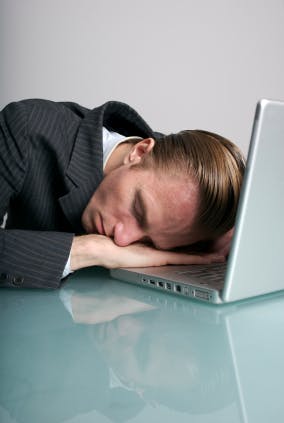If you get a bit tired after lunch, maybe you should sleep it off instead of grabbing another cup of coffee.
MetroNaps has something called an energy pod. It’s a self-contained napping container that looks like it came out of a sci-fi movie. According to their website, it uses NASA technology, which explains its form factor (and expense, which one website touts as around $13,000 per unit).
Office equipment in general is expensive, so $13,000 isn’t as bad as one might initially suspect. Would this be something compelling to offer employees? Could it help productivity?
The Energy Pod at work
The Huffington Post bought one of the MetroNaps pods for employees, as covered in Business Insider:
AOL/Huffington Post also has its own nap pod, according to one of its employees who snapped off this photo of the company’s pod.
This contraption is a MetroNap EnergyPod. MetroNap says it “harnesses science and NASA technology” to deliver a refreshing nap for users.”
As the article mentions, Google also has the pods as well.

I love this idea. Being a work-at-home employee, I forget what it is like to have to clog your way through a rough day at the office. There are times when I got up much earlier than usual, or, planned on staying up late. A quick 10-20 minute nap helped me cope with the difference in working time and it made a difference. My focus was sharper, I was able to concentrate much easier, and it felt like I got more work done.
In any case, having any sort of facility that allows an employee to comfortably relax seems like a smart idea. The idea of sleepy employees not being as productive is probably reason enough to offer a place for them to take a quick nap.
Power naps good, long naps not so much
Power naps can actually be quite beneficial, and not just for productivity like I expected. As US News reports:
Most employers who allow napping say they do so in the name of their staffers’ well-being, which research suggests is a smart idea. People who take daily 30-minute naps are 37 percent less likely to die of heart disease than those who don’t nap, according to a study published in the Archives of Internal Medicine in 2007. Naps can also boost the immune system — theoretically leading to fewer sick days — and propel employees into their most alert, energetic, and creative states, say nap advocates. Plus, a well-rested employee is a cheery employee, (Nancy) Collop, president-elect of the American Academy of Sleep Medicine. says: “If you’re sleep deprived, you’re going to be moody. And if you have to interact in meetings, or if you’re a marketing person and have to convince someone to buy your product, that’s going to create a problem.”
They also report that longer naps (those over 30 minutes) can do more harm than good. Sleeping for only 20-30 minutes rests you while not allowing you to go into a deeper sleep. If you take a longer nap, you could wake up with almost a hangover effect.
Rest as part of wellness
One of the things that isn’t typically emphasized in employer-driven wellness programs is the role of sleep as part of the health equation.
And part of that makes sense because work is often the reason our sleep patterns are so messed up. We get up too early or we stay up too late. We don’t eat breakfast because of this and might mistime lunch and dinner because of work commitments. I know I’ve eaten dinner at 10 pm and that doesn’t lead to a good night’s rest.
And lastly, we don’t allow employees to take a quick break when we naturally should be taking them. Every time we go against that urge, we’re hurting our bodies and our productivity.
And obviously you can’t take a nap all day and pretend to be productive, but certainly 15 minutes in a nap room (or pod, or tent) can help make those long days (or early/late days) much more manageable and better for ourselves too.
